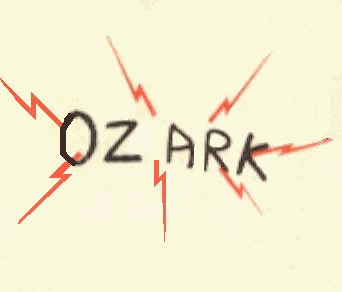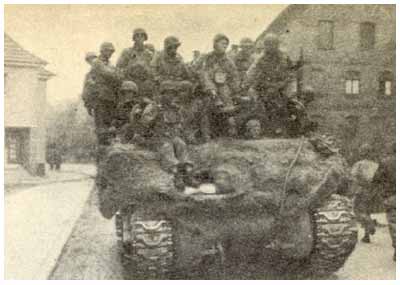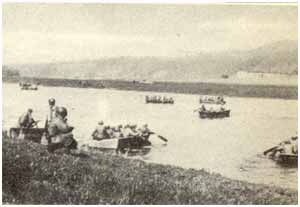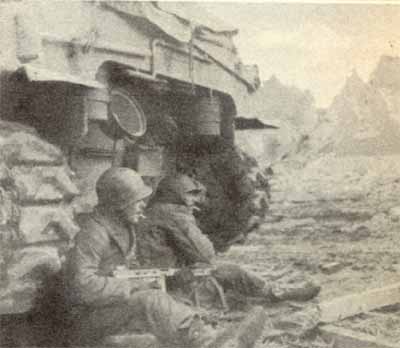36th Armored Infantry Regiment WWII
The 36th Armored Infantry Regiment
“Ozark”
 Men of the 36th Armored Infantry Regiment, “Blitz Doughs” of the 3d Armored Division trace their immediate history back to Brownsville, Texas, where the unit was activated in July, 1916, by personnel of the 4th, 26th, and 28th Infantry Regiments. The new organization did not go overseas in World War I, but saw service on the Mexican border.
Men of the 36th Armored Infantry Regiment, “Blitz Doughs” of the 3d Armored Division trace their immediate history back to Brownsville, Texas, where the unit was activated in July, 1916, by personnel of the 4th, 26th, and 28th Infantry Regiments. The new organization did not go overseas in World War I, but saw service on the Mexican border.
Reactivated by a cadre from the 41st Armored Infantry Regiment of the 2d Armored Division, on April 15, 1941, the 36th Armored Infantry Regiment became an original “Spearhead” element.
At Camp Beauregard, Louisiana, the first commander was Colonel Walton H. Walker, the officer who later became a Lt General in command of the famous XX “Ghost Corps” of the 3d American Army. Other commanders, during training at Camp Polk, Louisiana; Desert Training Center, California; Camp Picket, Virginia; and Indiantown Gap, Pennsylvania; were Colonel Edwin A. Smith, Colonel William L. Roberts, and Colonel Graeme G. Parks.
Upon arrival in England, during mid-September, 1943, the 36th was billeted at Sutton Veny, Wiltshire. With the rest of  the division, it maneuvered widely over Salisbury Plain, engaged in landing exercises along the British coast and took part in various special training courses.
the division, it maneuvered widely over Salisbury Plain, engaged in landing exercises along the British coast and took part in various special training courses.
Colonel Parks led the “Blitz Doughs” in their baptism of fire at Villiers Fossard, Normandy, but on July 18, 1944, he was succeeded by Colonel William W. Cornog, Jr. Colonel Cornog was the first regimental commander to be killed in action. From August 9 to September 23, 1944, the regiment was under the command of Lt. Colonel Jack R. Hutcheson, Colonel Louis P. Leone, and Colonel Carl J. Rohsenberger. At that time, Colonel Robert L. Hoxze, Jr., came to the regiment and led it through the remaining eight months of the European campaign.
Men of the 36th Armored Infantry Regiment figured prominently in every 3d Armored Division action on the continent. Companies “A” and “C” of the 1st Battalion, were the division’s first tactical units to be awarded the Distinguished Unit Citation. This honor was bestowed as the result of heroic fighting in the December Roer River salient. The entire 1st Battalion, commanded by Lt Colonel William R. Orr, was later awarded a Distinguished Unit Citation for its work in  storming the Siegfried Line. The action began during Orr’s first day in battle! That was the characteristic of the regimental spirit.
storming the Siegfried Line. The action began during Orr’s first day in battle! That was the characteristic of the regimental spirit.
The Distinguished Unit Citation was also given to men of the 2d and 3d Battalion medical sections for outstanding gallantry in action at Fromentel, France, and the Stolberg area, in Germany, respectively. And, in September, the 36th was declared a combat infantry regiment with more that 65 percent of its personnel wearing the coveted badge.
During the “Spearhead” Division’s five western campaigns, six separate commanders led the 36th Armored Infantry regiment. The casualty rate was even more severe in lower echelons. Colonel Orr’s 1st Battalion went into its initial action at Villiers Fossard, Normandy, under Lt Colonel Walter Abney. Before the unit reached German soil, three months later, it had been commanded by seven officers. They were Colonel Abney, Major Paul W. Corrigan, Captain John C. Chapman, Major Theodore F. Mason, Captain Frank D. Hall, Captain Louis F. Plummer, and Colonel Orr. Captain Plummer was wounded during the first phase of the Siegfried Line attack.
In the 2d Battalion, Lt Colonel Vincent E. Cockefair landed at the head of his troops in Normandy and was killed in  action on August 9. The records disclose that 14 succeeding officers commanded the battalion from that time until VE day! Of these, Major Thomas G. Tousey, Jr., and Lt Colonel Thomas J. Moran served longest, the latter fighting with his troops throughout the Roer-Rhine slug fest, the great Paderborn sweep, and the steady drive to Dessau.
action on August 9. The records disclose that 14 succeeding officers commanded the battalion from that time until VE day! Of these, Major Thomas G. Tousey, Jr., and Lt Colonel Thomas J. Moran served longest, the latter fighting with his troops throughout the Roer-Rhine slug fest, the great Paderborn sweep, and the steady drive to Dessau.
Lt Colonel Carlton P. Russell, wounded in action on August 5, 1944, was the first commander of the 3d Battalion. Eight other officers succeeded him, with Lt Colonel Paul L. Fowler, and Major Robert E. Chaney leading for the longest period of time. Major Chaney was killed in action ten days before the “Spearhead” Division came out of the line for the last time, at Dessau. Major Gorden Thomas then assumed command.
Many enlisted men of the 36th Armored Infantry Regiment game their lives to bring the final victory. The job of the “Blitz Doughs” was not an enviable one, and yet there was such esprit de corps among Colonel Howze’s troops that not one man would have changed places with a tanker. These men were the infighters of the division, the soldiers who insured victory after the cutting edge of the armor had slashed enemy positions. Indeed, in street fighting, the armored infantry often proceeded the tanks. For all the heavy casualties, constant fighting and fatigue, the “Blitz Doughs” maintained a brilliant reputation for valor.
| Name | Email Address |
| Bill McCaleb E Company | h.1.irwin@worldnet.att.net |
| Billy Houchens A Company | |
| Melvin Gelof H Company | |
| Fred Hyatt C company | |
| Malcolm Marsh A Company | |
| Vincent Tedesco HQ Company | |
| Clyde Upchurch HQ Company | |
| Bob Pacios A Company | Spearhead@cybertours.com |
